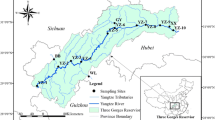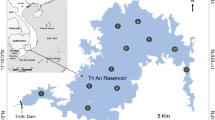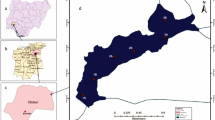Abstract
China’s “Environmental Quality Standards for Surface Water” (GB3838-2002) was combined with the Canadian Council of Ministers of the Environment Water Quality Index (CCME-WQI) to evaluate the water quality of the Three Gorges Reservoir (TGR) of China. The CCME-WQI values indicated that the overall water quality in the TGR remained stable and was ranked as “good” during the period 2010–2013. The water quality at the inflow sections of the Jialing and Wu Rivers was worse than that of the main channel (the Yangtze River), especially for backwater sections of these two tributaries. Total nitrogen, total phosphorus, and fecal coliform amounts were the three key pollutants affecting the water quality of the TGR. During low-water-level operation periods, the water quality of the TGR deteriorated. Human activities, such as the seasonal fertilization of croplands, appeared to be the main cause of the variation in water quality in different operation cycles. However, the relationship between water quality and reservoir operation cycles is complex and requires more research and data to be clarified. The CCME-WQI can be used to easily qualitatively and quantitatively assess whether the overall water quality meets the specified water objectives, and provides a clear indication of the water category. Compared with the single factor pollution index (SFPI) method, the CCME-WQI uses a group of typical criteria rather than worst-case criteria. The CCME-WQI, therefore, provides a more meaningful and comprehensive assessment than the SFPI method.



Similar content being viewed by others
References
Akkoyunlu A, Akiner ME (2012) Pollution evaluation in streams using water quality indices: a case study from Turkey’s Sapanca Lake Basin. Ecol Indic 18(5):501–511
Canadian Council of Ministers of the Environment (CCME) (2001) Canadian water quality guidelines for the protection of aquatic life: CCME water quality index 1.0, User’s manual. Canadian Council of Ministers of the Environment, Winnipeg
Canadian Council of Ministers of the Environment (CCME) (2006) A sensitivity analysis of the canadian water quality index. Canadian Council of Ministers of the Environment, Winnipeg
Cao CJ, Qin YW, Zheng BH et al (2008) Analysis of phosphorus distribution characters and their sources of the major input rivers of Three Gorges Reservoir. Environ Sci 29(2):310–315 (in Chinese with English abstract)
Chen XJ, Pan XJ, Zou X et al (2012) Studies on the temporal and spatial variation of water environment in Xiaojiang Backwater region of Three Gorges Reservoir. J Hydroecol 33(6):1–6 (in Chinese with English abstract)
Dunnette DA (1979) A geographically variable water quality index used in Oregon. J Water Pollut Control Fed 51(1):53–61
EI-Jabi N, Caissie D, Turkkan N (2014) Water quality index assessment under climate change. J Water Resour Prot 6(6):533–542
Feder DR (2004) A regionally base energy end-use strategy: case studies from centre country, Pennsylvania. Prof Geogr 56(2):185–200
Guo WX, Wang HX (2010) Optimal operation of Three Gorges Reservoir based on ant colony algorithm [C]. Int Conf Intell Comput Cognit Inf Los Alamitos IEEE Comput Soc. doi:10.1109/ICICCI.2010.101
Holbach A, Bi Y, Yuan Y, Wang L et al (2015) Environmental water body characteristics in major tributary backwater of the unique and strongly seasonal Three Gorges Reservoir China. Environ Sci Process Impacts 17(9):1641–1653
Hu T, Wang H, Hu X et al (2014) Analysis on regulation mode and operation of Three Gorges Reservoir in past decade. Yangtze River 45(9):24–29 (in Chinese with English abstract)
Huang ZL (2006) Water quality protection and advances on Three Gorges Reservoir. J Sichuan Univ (Eng Sci Ed) 38(5):7–15 (in Chinese with English abstract)
Hülya B (2010) Utilization of the water quality index method as a classification tool. Environ Monit Assess 167(1):115–124
Hurley T, Sdiq R, Mazumder A (2012) Adaptation and evaluation of the Canadian Council of Ministers of the Environment Water Quality Index (CCME WQI) for use as an effective tool to character tool to characterize drinking source water quality. Water Res 46(11):3544–3552
Ke XS, Fu Q (2013) Research on operation status of sewage treatment plants in Three Gorges Reservoir area. Yangtze River 44(20):72–75 (in Chinese with English abstract)
Khan AA, Paterson R, Khan H (2004) Modification and application of the Canadian Council of Minister of the environment water quality index (CCME-WQI) for the communication of drinking water quality data in Newfound land and Labrador. Water Qual Res J Can 39(3):289–293
Le TVH, Nguyen HN, Wolanski E et al (2007) The combined impact on the flooding in Vietnam’s Mekong River delta of local man-made structures, sea level rise, and dams upstream in the river catchment. Estuar Coast Shelf Sci 71:110–116. doi:10.1016/j.ecss.2006.08.021
Li CM, Huang ZL (2005) Study on the pollutant loads into Three Gorges Reservoir (I)-pollutant load status before impoundment. Resour Environ Yangtze Basin 14(5):611–622 (in Chinese with English abstract)
Li D, Zhang S, Huang C et al (2005) Investigation and control for fecal coliform pollution source in Chongqing municipal wastewater. China Water Wastewater 21(8):23–25 (in Chinese with English abstract)
Li Z, Guo JS, Fang F et al (2009) Potential impact of TN/TP ratio on the cycling of nitrogen in Xiaojiang backwater area. J Lake Sci 21(4):509–517 (in Chinese with English abstract)
Liu LY, Jiang CT, An BB et al (2012) Impacts of 175 meter water storage in Three Gorges Reservoir on water quality of Chongqing reach of Yangtze River. Water Resour Prot 28(2):34–36 (in Chinese with English abstract)
Lumb A, Halliwell D, Sharma T (2006) Application of the CCME water quality index to monitor water quality: a case of the Mackenzie River basin, Canada. Environ Monit Assess 113:411–429
Lv Y, Gong Z, Lian J et al (2007) Status of water quality in the Three Gorges after the water storage period. Res Environ Sci 20(1):1–6 (In Chinese with English abstract)
Meng JJ, Shen WM, Wu XQ (2005) Integrated landscape ecology evaluation based on RS/GIS of Three Gorges Area. Acta Sci Nat Univ Peking 41(2):295–302 (in Chinese with English abstract)
Ministry of Environmental Protection of the People’s Republic of China (MEP) (2002) State administration for quality supervision and inspection and quarantine of China. Environmental quality standards for surface water (GB 3838-2002). China Environmental Science Press, Beijing
Mugabe FT, Hodnett MG, Senzanje A (2003) Opportunities for increasing productive water use from dam water: a case study form semi-arid Zimbabwe. Agric Water Manag 62:149–163. doi:10.1016/S0378-3774(03)00077-5
Ouyang W, Hao FH, Song KY et al (2011) Cascade dam-induced hydrological disturbance and environmental impact in the upper steam of the Yellow River. Water Resour Manag 25(3):913–927
Qiu GS, Tu M, Ye D et al (2008) General investigation of eutrophication for tributaries in TGD reservoir. Yangtze River 39(13):1–4 (in Chinese with English abstract)
Rickwood CJ, Carr GM (2009) Development and sensitivity analysis of a global drinking water quality index. Environ Monitor Assess 156(156):73–90
Stone R (2011) Hydropower. The legacy of the Three Gorges Dam. Science 333(6044):817. doi:10.1126/science.333.6044.817
Tang JL, Wang T, Zhu B, Zhao P, Xiao Y, Wang R (2015) Tempo-spatical analysis of water quality in tributary bays of the Three Gorges Reservoir region (China). Environ Sci Pollut Res Int 22(21):16709–16720. doi:10.1007/s11356-015-4805-z
United States Environmental Protection Agency (USEPA) (2010) Total phosphorus. http://nepis.epa.gov/Exe/ZyPURL.cgi?Dockey=P10070OR.txt
Wang HX (2005) The agricultural non-point pollution in the TGP reservoir area and control countermeasures. Yangtze River 36(11):12–14 (in Chinese with English abstract)
Wang LJ, Zhai YJ, Zheng BH et al (2012) Study on water pollution prevention planning for the Three Gorges Reservoir area and its upper reaches. Res Environ Sci 25(12):1370–1377 (in Chinese with English abstract)
Wei GL, Yang ZF, Cui BS et al (2009) Impact of dam construction on water quality and water self-purification capacity of the Lancang River, China. Water Resour Manag 23(9):1763–1780
World Commission on Dams (WCD) (2000) Dams and development: a new framework for decision-making, vol 8-10. Earthscan, London, pp 75–93
Wu LJ, Shu D, Li Y et al (2013) Analysis of main stream water quality in Three Gorges Reservoir from the dam site up to Wanzhou. Environ Ecol Three Gorges 35(2):49–52 (in Chinese with English abstract)
Xie SP (2004) Study on the acceleration of navigation on the Chuanjiang River by the Three Gorge Dam at initial stage of filling dam. Transp Sci Technol 3:88–90
Xing M, Zhang X, He XQ (2008) Variation of water quality before and after Three Gorges Reservoir with 156-m water level. Environ Ecol Three Gorges 1(3):1–4 (in Chinese with English abstract)
Yan CA, Zhang WC, Zhang ZJ et al (2015) Assessment of water quality and identification of polluted risky regions based on field observation & GIS in the Honghe River Watershed, China. Plos One 10(3):1–13
Yang M, Zhang S, Hu ZS (2014) Characteristics and preliminary regulating factors of cyanobacterial bloom in Xiangxi Bay of Three Gorges Reservoir. J Lake Sci 26(3):371–378
Yin HL, Xu ZX (2008) Comparative study on typical river comprehensive water quality assessment methods. Resour Environ Yangtze Basin 17(5):729–733 (in Chinese with English abstract)
Yu MX, Qiu B, Xia F et al (2011) Research on water quality characteristics and variation of mainstream of Yangtze River before and after impoundment of Three Gorges Reservoir. Yangtze River 42(23):34–39 (in Chinese with English abstract)
Yuan C, Chen YB (2011) Research of adaptive management for ecological operation of the Three-Gorges Dam. Resour Environ Yangtze Basin 20(3):269–275 (in Chinese with English abstract)
Zhang M, Xu YY, Shao ML, Cai QH (2009) Spatiotemporal distribution of total nitrogen and total phosphorus in sediments of Xiangxi Bay, Three Gorges Reservoir. Chin J Appl Ecol 20(11):2799–2805 (in Chinese with English abstract)
Zhang YY, Xia J, Liang T, Shao QX (2010) Impact of water projects on river flow regimes and water quality in Huai River Basin. Water Resour Manag 24(5):889–908
Zhao P, Tang XY, Tang JL, Wang C (2013) Assessing water quality of Three Gorges Reservoir, China, over a five-year period from 2006 to 2011. Water Resour Manage 27(13):4545–4558. doi:10.1007/s11269-013-0425-x
Zheng SR (2011) Some consideration on related problems in pilot impoundment of TGP at designed water level of 175 m. Yangtze River 42(13):1–7 (in Chinese with English abstract)
Zheng BH, Cao CJ, Qin YW et al (2008) Analysis of nitrogen distribution characters and their sources of major input rivers of Three Gorges Reservoir. Environ Sci 29(1):1–6 (in Chinese with English abstract)
Zhuo HH, Lan J, Wu YL et al (2014) Study on influence of phosphorus pollution of Wujiang River to water quality in Three Gorges Reservoir. Yangtze River 45(4):66–69 (in Chinese with English abstract)
Author information
Authors and Affiliations
Corresponding author
Additional information
This article is part of a Topical Collection in Environmental Earth Sciences on ‘‘Environmental Research of the Three Gorges Reservoir’’, guest edited by Binghui Zheng, Shengrui Wang, Yanwen Qin, Stefan Norra, and Xiafu Liu.
Rights and permissions
About this article
Cite this article
Zhao, Y., Qin, Y., Zhang, L. et al. Water quality analysis for the Three Gorges Reservoir, China, from 2010 to 2013. Environ Earth Sci 75, 1225 (2016). https://doi.org/10.1007/s12665-016-5954-1
Received:
Accepted:
Published:
DOI: https://doi.org/10.1007/s12665-016-5954-1




